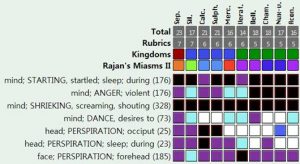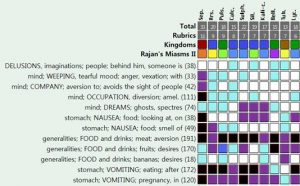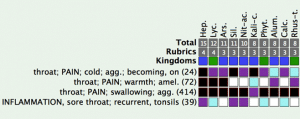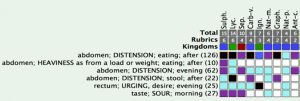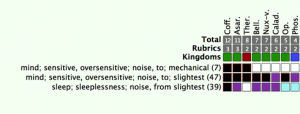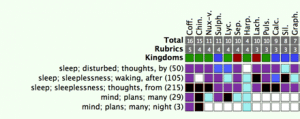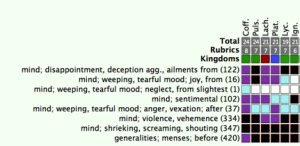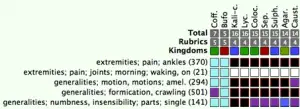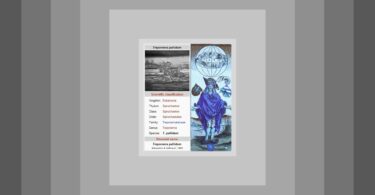Aafreen Chunawala and Pratik Jain
Editing: Armeen Jasavala
Editor’s note: 8 Box seminar announcement at end of this article.
Abstract: The main issue that has been stifling homeopaths for the past few decades is the consistency of results. There have been many classical and traditional approaches, which have had their share of successes and failures. At the same time, there have been many newer methods introduced, but none have been proven to be consistently reliable. A method that ensures the remedy is going to help the patient is drastically required.
Homoeopathy is an art and science that is based upon fundamental principles that have been used effectively in healing for hundreds of years. As time has progressed, the evolution of homoeopathic medicine has expanded significantly with each generation of practitioner.
“With the newest evolution of homoeopathic practice, we can produce a unique and innovative service for our fellow man. With trust, openness and good intentions on our side, we as a profession can grow and take forward the most beautiful and gentle method of healing, without overlooking the roots that our forefathers established. This synergistic integration of generations— both old and new—will be the legacy that lives on forever.” RajanSankaran, 2012
Being a third-generation homeopath, I have been acquainted with homeopathy since childhood. In my journey to becoming a homeopath, I have heard many stories and anecdotes about senior teachers and homeopaths. It has been fascinating to learn about the evolution of homoeopathy across generations and I have tried to share this learning throughout this article.
In homeopathic practice, we need consistency in results. Until this point, The Synergy Approach was utilized to bring about this very change. If we are able to look at three aspects of a case that all come to a similar point, namely Symptoms, Sensation and Genius, this helps us in achieving consistency.
However, this method was not clear enough. The Synergy Approach was good but students found it difficult to understand the whole methodology and it was not clear or easy enough to reproduce. At this junction, through trial and error, the idea of the 8-Box Method surfaced. Students and practitioners have found that this method is one the simplest and most reproducible approaches in homeopathy to date, allowing for great results in practice that are consistent.
Generally, the reason why there is failure in practice is because we ignore something in the case. We only want to select symptoms that are sure and clear, and most of the time, we only take the symptoms that fit into the remedy picture that we have in our mind. The 8-Box Method compels the practitioner or student to not ignore any aspect of the case.
There is a fine line to be drawn between what we should and should not ignore. We should not ignore anything that is sure, clear and individual, at whatever level the symptom might be found. We can ignore something that is not individual like the name or diagnosis of the disease (ex. Hypertension, Diabetes), these are broad and non-individualizing characteristics.
Individualizing the patient occurs when some kind of pattern is located. We have to examine the pattern of pathology or local symptoms and divide each symptom into Location, Sensation, Modality and Concomitants. We must give respect and importance to these symptoms. Then, we must examine the peculiar mind symptoms, local sensations, pace of disease, and miasm, to name a few. These all act as individualizing characteristics of the patient.
It must be said that the 8-Box Method does not mean we have to look at only 8 aspects of the case. This method presents a wider scope of vision, which allows one to look at all sides of the case. Wherever there are any sure-shot symptoms and individualizing characteristics, we must take them all into account, because then we will make fewer mistakes.
Once the patient’s information is categorized into 8 boxes, one must look at the clearest area and use it as the starting point or anchor. Here, one can identify the possible remedy and then use that as a reference point when looking at the other boxes.
The 8-Box Method allows for flexibility, as one methodology or another does not limit you. In some cases, there may be more or less boxes, but the idea is to know that all of the aspects of the case are important and should not be neglected. With this method, homeopaths can practice confidently and treat a whole range of cases, including deep pathologies and Sensation cases.
The 8-Box Method is a reproducible approach used to find the most correct remedy and it is one step ahead of Synergy. This is the latest and the most successful tool in Dr. Rajan Sankaran’s toolbox, which helps to further the development and practice of homeopathy.
The 8-Box Method will be illustrated through several case examples below, including serious pathological cases. This method is based on the concepts of exactness and completeness, and it is a very inclusive, harmonious approach to get the most consistent results in practice.
Illustrative Case Examples
Case 1
In some cases where different aspects of the patient like the chief complaint, the concomitants, the mental state, etc. can be elicited in detail, we can make totalities of these different areas of the individual’s life. The different totalities thus formed, also lead us to the same remedy. This helps in the confirmation of the remedy. Along with this, to help us confirm the remedy is the System and the Materia Medica.
I remember a case of 2-year-old child with complaints of delayed development (in higher functions like cognition/speech, gross and fine motor skills, physical growth). She was born prematurely in the eight month of pregnancy, but it was a normal delivery, and she cried well. However, she was a low birth weight (1.3 kg), and the mother could not breast-feed, as the baby could not suckle.
In May 2013, the child underwent a CT scan of her brain and found that there was sub-cortical infarcts in bilateral parietal regions, sequelae to previous Hypoxic Ischaemic Encephalopathy.
Throughout infancy, she would vomit everything that she had eaten. She had no interest in food nor could she eat properly, she had to be fed a liquid diet. She tended to get a cold easily at any change of weather. During colds, she vomits after eating. She sweats easily on the forehead and occiput, especially when asleep. Her stools and breath are very offensive. She has to strain even for soft stools, and at times she cries due to hard stools. She startles a lot during sleep, butnot wake up.
Nature
The child gets angry when she is not allowed to do what she wants to do and she starts screaming loudly. In anger, she will hit herself on the head, will knock her head against the floor, scratch others, pull their hair and throw things.She loves dancing and music. She has no strong fears except for when walking on a broken floor. She is a restless child, likes to imitate others, and tries to talk but ends up blabbering.While playing with objects, she will often throw them backwards.
Mother’s History During Pregnancy
The mother of the child explained that she had married against her will. The dislike for her husband and in-laws intensified during pregnancy.She would get angry with them especially when they would advise her about the do’s and don’ts of pregnancy. In anger she would weep as she could not express it otherwise.She had no desire at all to talk to anyone; she would remain totally silent. Keeping herself busy with arts and craft made her feel better.
She would frequently get frightful dreams of ghosts and would constantly feel that there was someone walking behind her. She dreaded to be alone, yet she had no desire to meet people.
She had developed strong nausea, which remained throughout the pregnancy. She would vomit after eating.It would be worse from odor of food or perfumes, and from the sight of food. She liked fruits, especially bananas. She developed a dislike for meat, which she was otherwise fond of.
Analysis With The 8 Box Method
| Diagnosis
Delayed development Due to Sub-cortical infarcts in bilateral parietal regions, sequelae to previous hypoxic ischaemic encephalopathy |
Chief Complaint
Vomiting after eating anything
|
Generals
Appetite – wanting, more liquid diet Takes cold easily Perspiration – forehead & occiput – when sleeping Stool & breath – offensive Stool – strains Startling during sleep |
Nature
Anger – contradiction Striking himself, scratching others, pulling hair & throwing things Restless Imitating Throws things backwards |
| MHDP
Married against her will Dislike for Husband & in-laws Anger – weeping Occupation amel No desire to talk to anyone Anger – when asked to do something she doesn’t want to do |
MHDP – dreams
Frightful dreams Delusion – someone is walking behind her Dreads being alone No desire to meet people |
MHDP – Generals
Nausea – Vomiting during pregnancy <sight & odor of food, perfumes Cr – fruits AV – meat |
Kingdom/ Miasm
Contradiction agg – common between Mother & child
|
Understanding of the Case – Characteristic Symptoms of the Child
*Scratching, banging head, and throwing are all expressions of violent anger
Symptoms of Mother during pregnancy
The Commonality between mother and child
- Child gets angry, when stopped from doing what she wants
- Mother gets angry when advised to do something that is she not willing to do
Remedy Chosen: Sepia 1M followed by LM8 (potency was selected due to the level of complaint – delayed development i.e. endocrine problem + tendency to colds i.e. poor immunity)
Sepia is missing in the rubric ‘development, arrested’ (although it is present in ‘growth affected, disorders of’). It is important to note that pathology becomes secondary if the individual symptoms are clear. Also ‘arrested development’ is a clinical rubric and not a proving symptom.
Case 2
This was a case of a 44-year-old man who came to see Dr. Sankaran even though he was feeling better from his chief complaint. He travelled all the way from Kolkata to cure his complaints that many would consider to be minor. His chief complaint was slight heaviness in the abdomen and only a little pain. These symptoms had improved with earlier homoeopathic medication, but he still wanted to see Dr. Sankaran.
He also mentioned thathe hadbowel problems and an aggravation after passing motions, where he would get slight pain after. He also mentioned some occasional heaviness in the center of the abdomen, which was aggravated after having lunch. He had bloating in the abdomen, which was aggravated after motion. There was a sour taste in the mouth after waking up in the morning and evening. He mentioned that he had recurrent sore throat and fever, which occurred after he drank cold water or other cold drinks.During fever, he becomes lethargic, his appetite decreases and this lasts for 1-2 hrs. The pain in throat is better by gargling with warm water.
He says he worries about the stomach issues mostly when travelling for work. He gets anxious that he should not have pain and his stomach should be ok. He feels because of these issues hewill not be able to do his job efficiently, which will compromise his position. He informed that once he had to leave early from work because of the problem, and felt bad that things would be pending. He would eventually have to cancel and postpone, which would cause him embarrassment. When asked about the feeling of embarrassment, he said,“I don’t tell them I am not well, I say I have some work to do. I don’t feel good that I have committed and I am unable to fulfill the committment…”.This situation makes him irritated anduncomfortable. He also feels insulted when someone says something bad about him, he feels defamed and not taken care of. These people are not abiding by the rules and unnecessarily he feels that he hasn’t performed well, resulting in a low and depressed mood. He even dreams of business and finding solutions.
He explained that when he is doing a job and it’s not going well, he gets tense and worried. Before, he was hardly ever nervous or tense. In school he was a bit shy, but not aware about nervousness before appearing in public. He has other complaints of back pain, extending to the right leg, which aggravates after a long workout. It is not severe pain, but disturbing. It is usually aggravated in the morning when he wakes up. Generally, he likes salty food, warm food, and eats a bit fast. He likes travelling, going to partiesand mixing with people. He is a light sleeper. He can tolerate cold better and is a hot patient. He cannot tolerate fasting. When starting a project, he says his level of self-confidence is goodand he takes up tasks that he knows he can do. He also complains of a loss of control in the right hand and he alsosweats more on that side. It would come and go, usually lasting for ten seconds and would be more if there were some stress or anxiety.
He is very attached to his daughter and if she is not well then he feels uncomfortable. He explains that he loves his daughter more than his son. He also said that he cries when someone dies. Other symptoms include anger after sweating and experiencing an uncomfortable feeling in small rooms.
Analysis with the 8 box method
| Diagnosis
Gastritis Tonsillitis
|
Chief Complaint
Slight heaviness in abdomen and little pain Bowel problems Recurring sore throat & fever after cold drinks |
Generals
Likes salty, warm Eats bit fast Perspiration – right side, affected side on Baldness – young people Fasting agg Light sleep Hot patient
|
Mind state
Frowning Timidity in public Embarrassment Mortification Narrow places agg Crowd agg Anger after sweating Dreams – drowning |
| Throat
Cold agg Warm amel Tonsillitis Pain <swallowing Inflammation – recurrent |
Abdomen
Distention after eating <evening, after stool Heaviness <after eating Taste – sour <morning Urging <evening |
Pattern/ Genius
Trivial nature of complaints All complaints are ‘little bit’
|
Kingdom/ Miasm
Not clear |
Understanding of the case
In this case, the first thing to take note of is the trivial nature of the patient’s complaints. Throughout, he would constantly use the expression, ‘a little bit (or thodasa)’ when describing any and every aspect of his life including business problems, stress, and pain in the abdomen, in this way. Every problem that he spoke about was solvable. For example, he would say things like, “I take up a project that I can handle…my pain is curable…I am very hopeful.”
Here, we see optimism and no desperation. This represents the Psoric Miasm. This Miasm represents the depth and desperation of the patient, as well as the sensation. It is how acute and how intense the symptom is, and how the patient perceives the situations in their life. There are some individuals that even after having a grave disease, they are not serious about it, and then there are some cases that have trivial symptoms where the patient is very anxious about it.
Miasm is the depth and pace of the sensation. That is how deeply the fear and panic is experienced. We have to understand what is the magnitude of this perception. In every expression of the patient we should see the same pace and experience all the way through. In another individual, the same panic and fear may be experienced at a different depth and at a different level.
The prominent mental symptoms were repertorized as follows:
Dr. Sankaran gathered symptoms from different areas of the patient’s life:
Throat
Abdomen
Generalities
From the above analysis, the remedy that we came to was Lycopodium. The most important characteristic and individualizing factor in this case was that any problem faced by the patient was easy and solvable. The patient is hopeful and not desperate. So, we should be aware that we are entering a Psoric miasm.
What was also obvious was the level of experience, that is, how an individual perceivestheir individual state. There were only local symptoms that caused some kind of anxiety and discomfort. There were no prominent dreams, which indicate a clear case of Level 3.
As the patient was on this level, we know that the kingdom or sensation would not be clear. When a patient is at Level 3 we have to rely on the symptoms, either the local characteristics, emotional symptoms or symptoms that are a crossover, that being, emotional symptoms having an effect on the physicals or vice versa. Through this case, one learns how to narrow down the specific areas of sensitivity and note the exact sensitivity in such cases. Here, we also learn how to avoid getting lost in a maze of symptoms.
Dr. Sankaran also teaches us that each case should be viewed in an individual way, where the case guides the approach that is to be taken. He stresses taking a “backseat” while case-taking and having an overview of the patient. For example, noting who he or she is and what is his or her personality. He refers to this as zooming out and viewing the whole forest, and then later on, zooming in to the minute details where one observes the characteristics of every tree. He speaks of subtly understanding the patients.
Remedy Chosen: Lycopodium 200C
Case 3
I saw a case of Dr. Sankaran where a woman had come with a very peculiar complaint of sensitivity to noise. She gave so many examples about her hearing being acute to noise and how she had difficulty sleeping because of that. For example, the noise of the fan, washing machine or any mechanical noise was a bother. She also described her sleep complaints, her dreams and also her complaints during menses.
Let us read the case notes and analyze it together (questions written in bold).
What is the problem?
I am very sensitive to noise. Even slight noises or multiple sounds together. I constantly keep hushing people, slowing down the fans, switching off the TV, etc. It is a constant distraction for me and my attention goes there. It is a nagging feeling.
What happens to you?
It need to turn it off. Even the neighbor’s fan is like a motor for me, I want it to be taken care of. The noisedoes not bother others in the house or the neighbor who stays with the fan. I sleep better when noises are not there
What feeling does it create in you?
Irritation, distraction, and the urge to put it off.
Experience of irritation?
I get restless.
What kind of noise bothers you the most?
My attention keeps going to all of the little background sounds. The TV volume has to be only at 10 and the fan speed at 1. It must be as silent as possible. I hear the small noises like the fan, exhaust fan, washing machine, air conditioner, typing, something rattling constantly, honking, rattling of the car etc. All of this bothers and irritates me. I sleep better when it is quiet.
What about dreams?
I had this one dream where I was consulting a man who was correcting image, and he was straightening my teeth. I dream more of what is on my mind, work that needs to be done, errands that need to be done. I do not sleep well, I keep waking. If I have to get up at 6, I will wake up at least twice to check the time. Before an event I am completely worked up.
Tell more about this.
At times, my sleep goes away and I surf the internet because I cannot sleep.
It is not always easy to fall asleep. I get thoughts of what needs to be done. If my sleep is broken, I think a lot about business plans, ideas for work, thinking about what new things I can take on. Sometimes I read about my work too, I am a florist, so I am reading about what I can do to improvise, and look at various business plans.I go scouting on Google for all the answers.
What attracted you to this work?
Firstly it was need basedand I wanted something close to home. I happened to go through a magazine and checked out few ideas. I like the creation, designing, styling and visuals. You are adding beauty to something.
What do you mean by beauty?
Flowers liven up the atmosphere, they are colorful.
What is the experience of ‘liven up’?
It is like a spark or bounce. There is a little more energy. My eyes becoming happier, I am smiling. It is more about having variation in the same thing, experimenting, and the visual appeal.
Again, what dreams do you get?
I get lots of dreams of trains, where I am either catching or traveling in a train. I dream of Greece-like places that are very beautiful with white houses, pretty pools, and a train travelling through. The water is crystal clear and it gives a WOW feeling.
Describe this wow feeling.
It really is something you do not want to miss out on. It gives joy, excitement, I feel upliftment, something raising, bouncing.
What is the experience within you?
You are out. It is like breaking out of a barrier, which is not regular.
What is the exact opposite feeling?
Being in a cocoon. There is no light. There is darkness. I am claustrophobic. There is no movement. I am breathless, there is no movement. I am tied. Bound. Just this dark shell, no movement to get out.I want to run away. I do not want those things to come. I would rather divert myself then have this feeling.
What else can you tell about yourself?
I was reading about something and I came across this personality type, hypersensitive, which I feel I am. If a close friend doesn’t call me it affects me, I will keep brooding over it a lot.
What will you experience?
I feel neglected and used. I ask, why is it always me who is doing things for her
What else are you sensitive to?
Everything. I get sentimental when I watch emotional advertisements or when I go for a parent-teacher meeting and they say good things about my son. i get emotional when I read touching messages, or when I see people squatting on the railway tracks I cry. I sob in movies too. I am very sentimental over small things. A week before my menses I am volatile.
Describe the word volatile.
I say anything I want. I am abusive. I repeat things that have happened overthe last 20 years of marriage. I tell my husband I want to end it and he says he wants to end it because of my behavior. If he doesn’t answer my call I send him thousands of messages.
When angry, what physical symptoms come?
Body temperature is warm and my hands would tremble.
What is the feeling at that time?
I just want to let the person know it, to understand it, I will think of hundreds of moments from past where understanding wasn’t there. Maybe I need attention, I am getting it all out and I am communicating, but he still cannot figure out how to be with me.I mainly feel anger and sadness. This all happens one week before my menses comes. On the first day of my menses, this mellows. I am suddenly calm. Sometimes I can go berserk on my staff, I have to control myself.
What are your hobbies and interests?
I love to travel, be with friends or do nothing. I would love to go to the mountains. It is such a lovely view, crystal clear and there is not too much noise. It is tranquil, peaceful, and natural.
What do you crave in food and drinks?
Cheese, peanut butter, jam, chips, and burgers. I would rather have an alcoholic cocktail rather than coke. No cravings in particular, I like tea with ginger.
Anything else?
Another thing is I get joint pain in my ankle, especially when I sit cross-legged. The first few steps are stiff and then it is fine. My hands go numb at night when I sleep, especially after I sleep with my hands under my head.I get formication in legs and started noticing pain in the right shoulder blade, especially when I lie on that side.
Analysis with The 8 Box Method
| Diagnosis
Hypersensitivity to Noise
|
Chief Complaint
– Slightest noise To Noise of TV, Fan, Grinder, Exhaust Fan, AC etc – When there are these type of Noises, my attention goes there Feels Irritated
|
Generals
Sleep Disturbed Before Menses becomes VOLATILE – Abusive – Angry – Wants to break the marriage |
Interest & Hobbies
Likes to Travel Mountains – Lovely View, Crystal clear, No Noise Tranquil, Peaceful & Beautiful Place Works as a Florist
|
| Dreams
Dreams of Catching or Travelling in a train Sees beautiful White Houses, Pretty Pools, Crystal clear Water
|
Mind State
Hypersensitive Sentimental Sensitive – to Emotional advertisements Weeps – on seeing People squatting on railway track, feels bad for them Thoughts about Work Makes lot of Plans Irritability before menses |
Experience
Joy, Excitement, Creativity, New ideas, WOW feeling, Upliftment, Raising, Bounce, Experimenting, Corlorful Opposite – Being in a cocoon, Dark, Claustrophobia, No movement, Tied, Bound Want to run away
|
Kingdom/ Miasm
Hints of Plant Kingdom
|
The following case was repertorised as follows:
Chief Complaint
The remedy that came up was Coffea. The question now was should we give Coffea? In order to be sure, Dr. Sankaran checked the other sets of symptoms.He confirmed the other symptoms of the case in the form of different sectorial totalities as given below.
The second set of symptoms were her sleep symptoms:
The third set of symptoms were before and during her menses:
The fourth set were her general symptoms:
As we see from the different sectorial totalities above, the remedy that comes up repeatedly is Coffea. After creating the sectorial analysis, we have to confirm from the System understanding and Materia Medica. Since the miasm was Tubercular (wants to get out of marriage, feels bound or tied up, she wants to break out) and the sensation was from the Rubiaceae family (too many ideas and thoughts causing sleeplessness, creativity, the floral designs, beautiful landscapes, tranquility, over stimulated, bouncy, excited, too much affected by joy) was coming up clearly, we can very confidently confirm the remedy as Coffea Cruda.
Conclusion:
The 8 Box Method helps us avoid getting lost in the trove of information that we receive from the patient and helps us to focus on the characteristics in the easiest possible way. The 8 Box Method gives us an overview of the essentials in the case, and together with the vital characteristics, it allows for a simplified and well organized approach to solving cases. This method also reduces confusion with all the stories we receive from the patient and allows space for the doctor to remain grounded in the most important aspects of the case.
Seminars: The 8 box Method Seminar – Dr. Rajan Sankaran
January 20,21st – 2018
Location COEP COLLEGE, Pune, Maharashtra, India.
Description- 8 Box Method
Contact person and email address – Prana 020-66482200/22
Website to register – www.theothersong.com
AND…
May 3-6, 2018 – San Francisco Theological Seminary, San Anselmo, CA (U.S.)
Contact: [email protected]
The 8 Box Method is one step further than the idea of Synergy. This is the latest and the most successful tool so far in Dr Rajan Sankaran’s development of the practice of Homeopathy. This method will be illustrated with several cases including pathological cases. The box method is based on the concept of Exactness and Completeness


